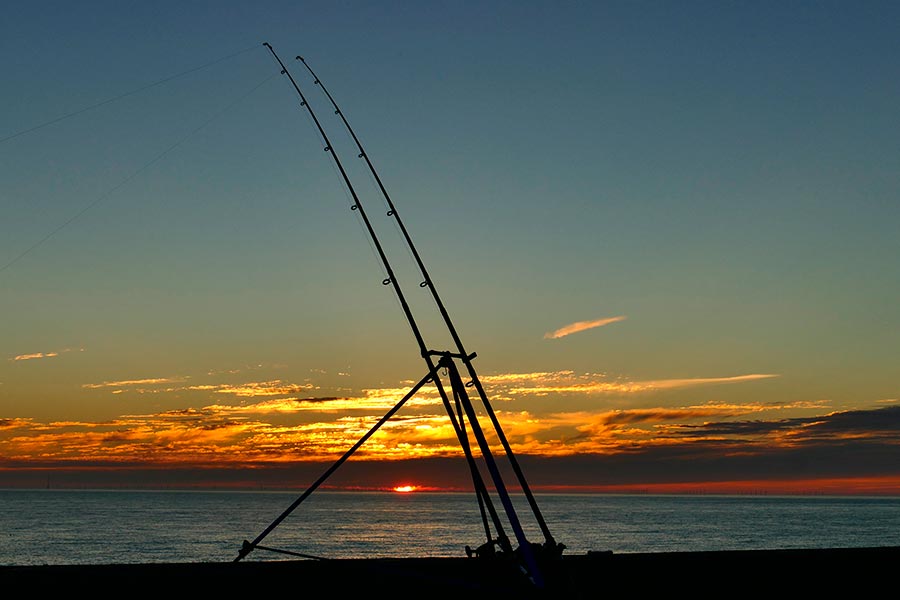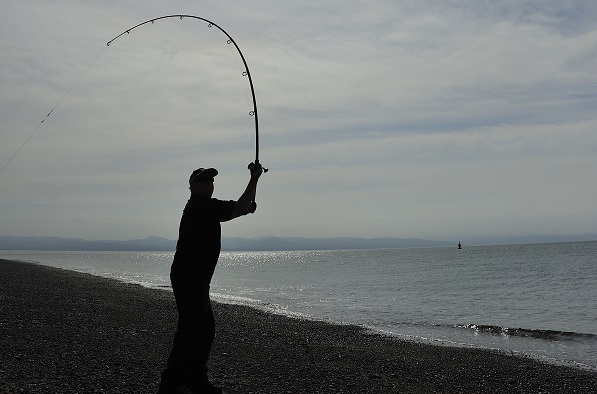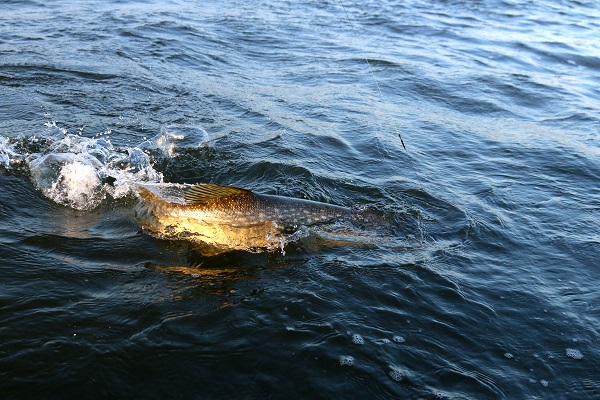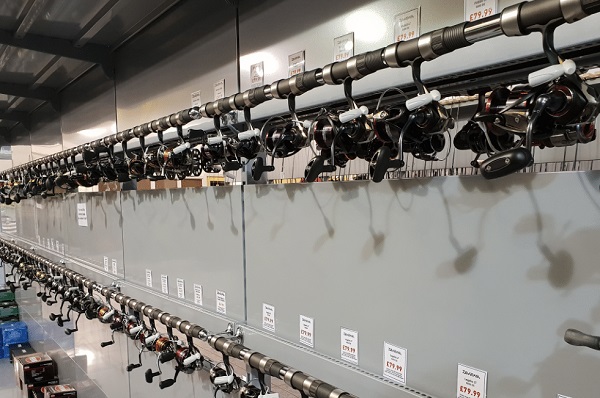Sandy beaches, scenic coastlines, coastal villages! Sound nice? Well, these are some of the surroundings you will experience seashore fishing. With so many rods, reels, rigs and even fish species. Sea fishing can feel quite daunting for any beginner. In this article, we will give you a basic break down of the equipment required for beach casting and explain how it all works. Let’s get into it!

Beachcasting Rods
A beachcaster is typically a beach rod that is used from the shore for sea fishing. Beach casters can range from 12′ to 16′ in length and designed to cast 4 – 8oz leads a long distance.
Traditionally the average length of a beach caster was around about 12′ – 13′, but in recent years, trends from the European market have seen the introduction of longer and lighter rods of up to 16′ in length. This is due to their greater sensitivity and their ability to cast further (Please note, that this will come down to each individuals casting ability and technique) The rule of thumb nowadays is, longer the rod, the longer the leverage and bigger the spring which means the further casting capabilities of the rod.
To save any further confusion, Beachcasters and Surfcasters are exactly the same and is merely the way rods are marketed that determine their name.
Rod Action
Although there are various rod actions available. There are 2 main rod action types for beach casting, below we have a look at both of them:

A fast action rod being compressed under load.
Fast Action
Designed specifically for power casting. The action comes from the top quarter of the rod, allowing the rod blank to really compress under load and recover quickly during the cast. These rods will also be longer in length and will usually come with a sliding reel seat to accommodate custom reel positions and casting arm distance length to optimise casting performance for each individual. These rods are designed for pendulum/competition casting techniques, making them ideal for distance fishing.
Progressive Action
This rod action allows the rod blank to bend through its entire length. This rod action is often found in the shorter range of beach casting rods in the 12′ – 13′ range. They’re more forgiving than fast actioned rods and are easier to cast for a beginner. They are ideal for overhead or off the ground casting techniques. Regularly used with fixed spool setups. These rods are ideal for closer range work.
Casting weight
As previously mentioned, casting weights are quite broad on beach rods. However, there is a rule of thumb when it comes to casting weights. Let’s have a look at the break down:
- 2 – 5oz – Ideal casting weights for estuaries and low to medium tidal swells. Also perfect for shorter range fishing or when finesse presentations are required.
- 5 – 8oz – Ideal for long range fishing on open beaches and can deal with medium to heavy tidal swells.
Weights of 5 – 6oz are seen as the optimum casting weight for anglers. Heavy enough to hold the bottom firmly but manageable to cast, even for the beginner.
Sea Fishing Reels
You have 2 types of reels that can be used with a beachcaster, an open spool reel or a multiplier reel. Below we break down the two:
Multiplier
A beach caster designed for fishing with a multiplier will usually come equipped with a trigger grip handle for a better and more efficient grip for casting. A multiplier is a reel that the spool is driven directly by its gearing. The reel itself is barrel-shaped and is held and used with the reel facing upwards. The rods guides will also face upwards (think of a rod turned up the other way)
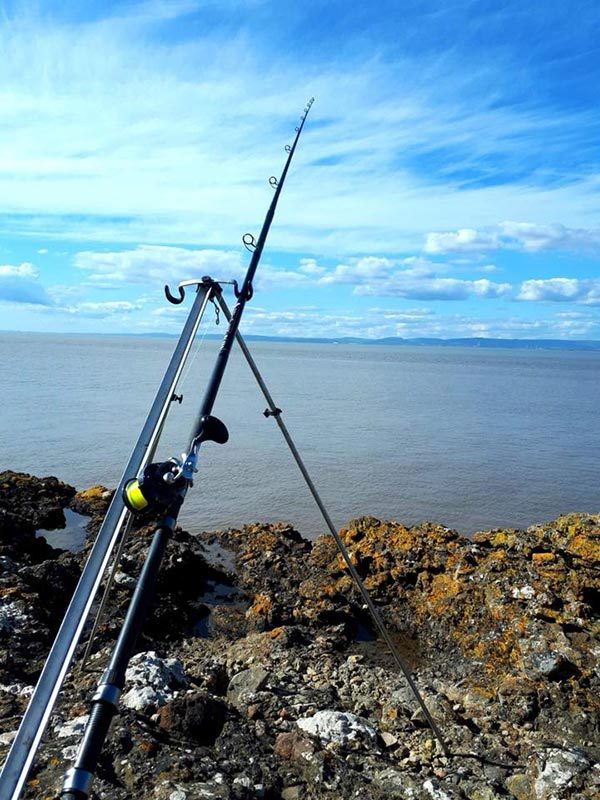
A beachcaster rigged up with a multiplier
Another way to differentiate a multiplier designed rod is the closer spaced and smaller guide sizes, compared to a fixed spool setup up. This is due to the compact linear way multipliers pay off line during the cast. These style of reels do require your full concentration during use as you are required to manage the line during the cast due to the free rotating spool. This means the spool on the multiplier has to be controlled using your thumb during the cast. When the rig and weight enter the water, it is vital that you stop the multipliers spool with your thumb to prevent an overrun occurring. An overrun is when the multiplier spool is still spinning and loops of line leave the spool to quick resulting in the line loops tangling creating a birds nest like effect. The majority of beach casting multipliers are right-hand wind, so ensure you feel comfortable with the reel handle positioning. Multipliers do take a bit of time to perfect using and we do recommend beginners start with a fixed spool set up first.
Fixed Spool
This is the ideal reel for beginners and takes less concentration on the cast and less practice to perfect. The reel locates on the bottom of the rod (facing the ground) The spool is fixed on the front of the reel (Thus the name – fixed spool) the spool does not move during the cast. The line pays off the spool in loops during the cast, meaning fixed spool beachcasters require larger guides with further spacing which reduces friction on the cast, this allows the line to straighten the further it goes down the funnel effect of the guides. This style of reel are also ambidextrous, this allows the reel handle to be swapped onto the opposite side of the reel body. Fixed spool reels have become more popular of recent years, due to the influence of the European market. We do recommend wearing a finger stall (a finger glove) when using heavy leads and distance casting, as the line leaving your finger will be under a lot of pressure and will create a lot of friction.
When it comes down to choosing a reel for your beachcaster set up, it really comes down to personal preference. There is not much between the two and in the right hands, both will cast and perform as well as one another. The main thing to remember is that both fixed spool and multiplier setups do differ. Your best bet is to pick up both and see what feels more natural in hand.
Sea Fishing Rigs
There are two main kinds of rigs that are commonly used in beach casting. Here we will have a look at them in a bit more detail:
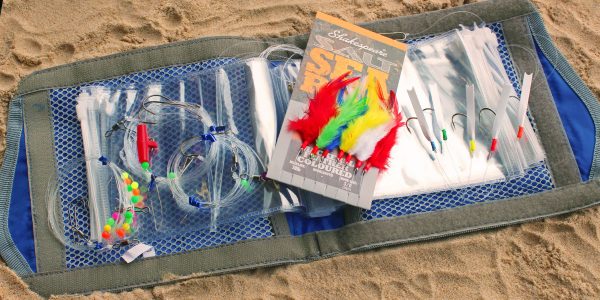
Using a rig wallet allows you to store your rigs away neatly
Flapper Rigs
This is a great all-round rig which can be used to target several species. Ideal for beach fishing, as it’s designed to be fished in snag-free water. With this two hook rig, you can fish two different baits at the same time, which in turn will increase your chances of catching. These rigs come with either 1, 2 or 3 hook lengths. These rigs are ideal for close to medium work, due to the rigs lack of aerodynamics.
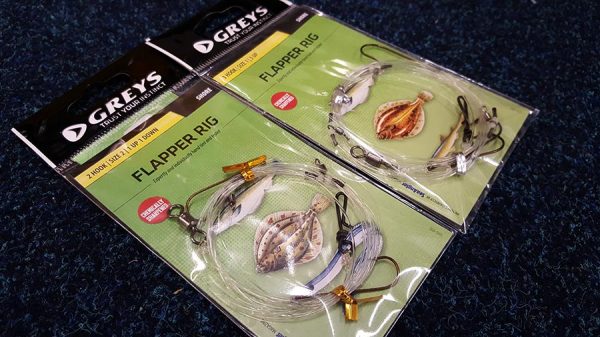
We have a full range of ready made beachcasting rigs
Clipped Down Rigs
These rigs are solely designed for distance fishing. The baited hook and hook length is clipped down parallel to the rest of the rig via hook clips located on the rig itself. This improves the rigs aerodynamics and decreases the chances of the rig tangling. On impact to the water, the hooks release and become free, giving you the same presentation as the flapping rig.
Sea Fishing Weights
As previously discussed, rod casting weights can be anywhere between 4 – 8oz. Using leads at 5oz in weight is a good starting point and will cover most situations but like any form of fishing, balancing your tackle to the conditions and venue you’re fishing are key. E.g. Heavy weights would be ideal for heavy tidal swells and distance fishing and lighter weights would be better closer range work.
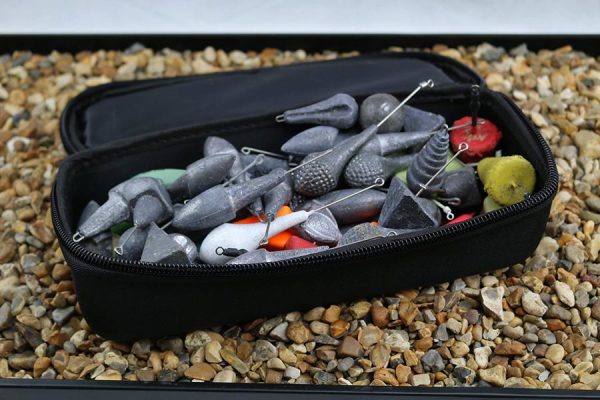
Having a selection of weights to tackle different scenarios will allow you to fish efficiently
Weights come in various shapes and sizes and specifically designed to anchor in certain bottom types. Let’s have a look at some of the examples available on the market.
- Distance bombs – Ideal for long range fishing, aerodynamically designed for gaining distance.
- Grip wire leads – These leads have wires that protrude out them, designed to anchor/grip to the bottom in rough tidal conditions.
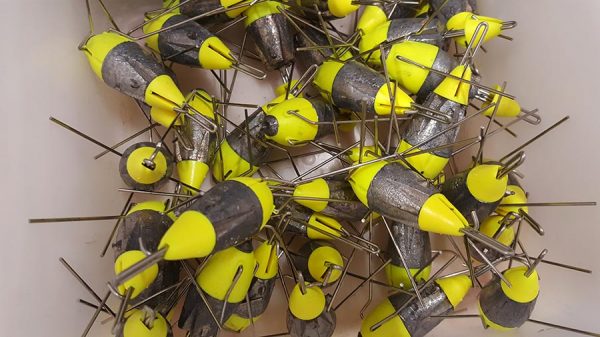
Grip wire leads are designed to hold your rig in tidal water
Shock leader
Shock leader’s are a length of line that is designed to absorb the pressure of casting heavy weights and rigs. Just imagine, the pressure put on your main line when you’re applying power and force during a cast with a rig and a 6oz lead. Scary isn’t it! We use shock leaders to absorb that pressure put on our mainline. Inevitably it’s a safety mechanism during the cast.
Shock leaders are usually made up of a heavy duty monofilament or copolymer line. The general rule of thumb is 10lb breaking strain for every ounce of weight used. E.g. 60lb shock leader for a 6oz lead.
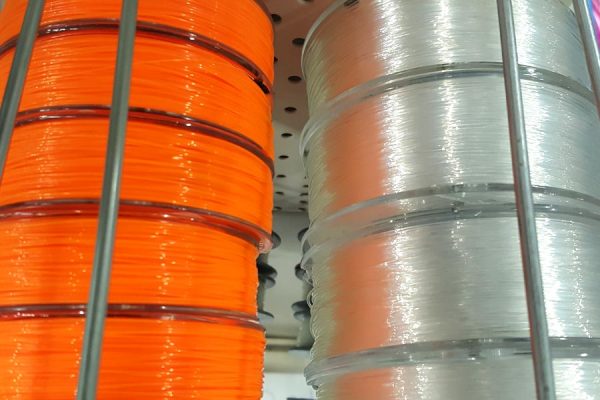
Shockleaders are essential for absorbing the pressure of casting heavy weights and rigs
The shock leader attaches to your main line via a uni to uni knot (Or any knot designed for tying line to line) The end of the shock leader is then tied to your rig. Ensure the breaking strain of your shock leader matches the line used on the rig body itself. The shock leader then attaches to your rig by a clip or swivel, allowing you to change rigs quickly and easily.
Shockleader length
Shock leader length comes down to personal preference. However, the absolute minimum should be twice the length of your beachcaster and about 6 turns left on your reel. This provides you enough shock leader to absorb any pressure from the weight and rig, without it putting unwanted strain on your mainline.
Line
When it comes to choosing the correct line for beach casting, there are various brands and breaking strains available on the market and it can become quite confusing choosing the correct line for the job. Line choice is a balance of diameter vs breaking strains. Looking for a low diameter line with a high breaking strain would be advantageous for distance casting. However, a low diameter line would not be beneficial over rougher ground where a high diameter and more abrasion resistant line would be more suitable. There are two types of lines we recommend: monofilament lines or braided lines, here we have a look at the benefits of both.
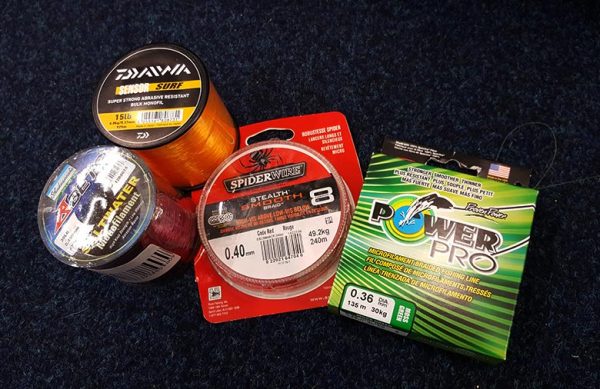
Picking the right line for the marks you are fishing over is vital
Monofilament Lines
Monofilament lines in 15-25lb breaking strain are recommended. This breaking strain of line is heavy enough to deal with hard fighting fish but also strong enough to pull your terminal tackle out of snags if the need arises.
Pros
- – Abrasion-resistant
- – Breaks above its stated breaking strain
- – Good knot strength
- – Casts smoothly
Braid
Braided lines are made up of woven fibres of man-made materials such as Dacron, Spectra or micro-Dyneema into a strand of line. We recommend 65lb breaking strain braided lines and this is based on the diameter of the line. A general rule of thumb is to match the diameter of a braided line to the same diameter of monofilament line that you would use for pike fishing. So, in this case, 15lb monofilament 0.370mm against 0.36mm of 65lb braided line.
Pros
- – No stretch, so keeps you in contact with the fish and better bite detection.
- – Low diameter and higher breaking strains compared to conventional lines.
- – Line has no memory, so does not coil like conventional lines.
- – Better lifespan than more conventional lines – can be more cost-effective.
What species?
The exciting thing about sea fishing is not knowing what you’re going to catch. Unless you specifically use certain tactics and rigs to target certain species. You can have so much fun using the rigs that we have recommended in this article. Fish species you are likely to encounter, depending on the time of the year, are: Flounder, Flatties, Plaice, Dab, Cod, Bass, Pouting, Whiting and more.
Summary
After reading this article, we hope you’ve gained a better understanding of using a beachcaster setup from the shore. It’s a very exciting form of fishing, with the ability to catch various saltwater species and be surrounded by the best coastlines the UK has to offer.


